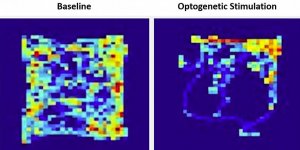| News / Science News |
Controlling Brain Circuits in Mice
NIH | MAY 22, 2015
Researchers developed a tool that can turn specific sets of neurons on and off in mice to affect behavior.
In 2007, a team of the University of North Carolina School of Medicine developed a technology dubbed DREADD—Designer Receptors Exclusively Activated by Designer Drugs. DREADDs are protein receptors altered in a lab so that only a specific synthetic chemical can bind and activate them.
Scientists can then create genetically modified animals in which only a specific set of neurons contains the receptor. Only neurons expressing the DREADD respond to the compound. Thus, scientists can explore what happens when those particular neurons are turned on or off.
Until recently, all DREADDs were activated by a chemical called clozapine-N-oxide (CNO).
A team of researchers developed a new DREADD by changing the structure of a naturally occurring receptor called the κ-opioid receptor (KOR).
To create a KOR DREADD, or KORD, the researchers mutated KOR so that it was activated by a synthetic chemical called salvinorin B. This chemical could only bind very weakly to KOR and not at all to other receptors in the body.
The researchers next created genetically modified mice whose brains contained a set of neurons expressing both KORD and a CNO-activated DREADD called hM3Dq. Both movement and feeding could be altered by giving the mice either salvinorin B or CNO. For the first time, scientists could use chemicals to control a neuronal circuit in 2 directions in the same animal.
YOU MAY ALSO LIKE



